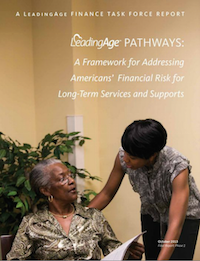
A combination of private and public approaches to financing long-term services and supports can help those who need such services while reducing the burden on the Medicaid program. So said the presenters at a LeadingAge annual meeting educational session providing hints about the latest findings of its Pathways project, a $1.3 million effort of which results formally will be revealed Nov. 17, as McKnight’s Senior Living previously announced.
The current financing of aging services “is not a pretty picture,” Larry Minnix, LeadingAge president and CEO, told attendees. The government spends $367 billion annually, much of it for nursing home care paid by Medicaid, he said, and the public spends $450 billion annually.
“There are 10,000 people who turn 65 every day, and in today’s dollars, every one of those people can expect to have to have $70,000 in cash set aside to pay for their needs, at a time when people are not planning well,” Minnix said. Average assets, including a house, total $100,000, and about 15% of the population will need long-term care for five years or longer, he said. “We are totally unprepared for what’s facing us, and most of the public thinks that Medicare or Medicaid—and sometimes they don’t know the difference—is paying for all of that, and they’re not,” Minnix added.
LeadingAge has been working on the issue for 10 years, he said. With input from Washington, D.C., think tanks, representatives of the insurance and actuarial industries and others, the association released an initial report titled “Pathways: A Framework for Addressing Americans’ Financial Risk for Long-Term Services and Supports” two years ago. The document outlined seven options to address financing LTSS in the United States, including maintaining the status quo. “It is probably the best summary of the situation for the American public that you’ll find anywhere today,” Minnix said.
LeadingAge, the AARP and the SCAN Foundation commissioned economic modeling of several of the options by the Urban Institute and actuarial firm Milliman based on certain assumptions about costs, utilization, level of use and other factors. The results, which will be published in Health Affairs, “will change everybody’s business model, and there will be some new categories that will emerge out of this that we haven’t done before,” Minnix predicted. Revenue, rather than reimbursement, will be the focus for providers, he said, and those who already offer home- and community-based services, CCRC at Home and PACE will be ahead of the game.
Specifically, ideas being investigated include a voluntary private insurance product that would cover the first couple of years that someone needs LTSS, a mandatory public program (with subsidized premiums for those who have lower incomes) that would cover all LTSS needs after two or three years, and a more a comprehensive proposal. “We think these studies are going to show that through some kind of ‘combination platter’ of private and public approaches to this, we can significantly help families mitigate against these problems and help take the burden off of the current Medicaid program, which can’t handle what it has,” Minnix said.
Including everyone in the risk pool, however—that is, making the program mandatory—has the potential to reduce Medicaid and out-of-pocket spending, said health and aging services expert Anne Tumlinson; if the program is voluntary, it is likely that only those who need services would enroll, so costs would be higher.
The modeling, Tumlinson added, will answer these questions about each option: “How does it change out-of-pocket spending over the next 70 years? How does it change Medicaid spending? Who’s covered, and how many people are covered? How does it change total spending? And how much does it cost to do that—what do people have to pay individually, either under a voluntary or mandatory program, in order to get the kind of effects that they might be looking for?”
Tumlinson said that the finding she thinks is most exciting “is that when we test the impact of these different insurance approaches…they add money to the pot. There’s unmet need that becomes met, so people will have money to buy things to meet their needs.”
Armed with the results of the modeling, Minnix said, LeadingAge hopes to suggest legislation before the next session of Congress begins and the next president enters the White House, and it could appeal to both Republicans and Democrats. Referring to new Speaker of the House Paul Ryan (R-WI) and House Minority Leader Nancy Pelosi (D-CA), he said: “I’d like to think that what we could show Mr. Ryan and others is, ‘Here’s a way to stem the tide on Medicaid.’ I’d like to be able to show Ms. Pelosi, ‘Here’s a way to have coverage for a lot more people at an affordable price through this combo platter,’ ” he said. “I’d like to tell Mr. Ryan, ‘Here’s a private market solution,’ and I’d like to tell Ms. Pelosi, ‘Here’s a public option solution.’ ”
Some policymakers might think that addressing the issue will be too expensive, Tumlinson said. “I don’t know that we can afford the status quo,” she added.
Lois A. Bowers is senior editor of McKnight’s Senior Living. Follow her on Twitter at @Lois_Bowers.



